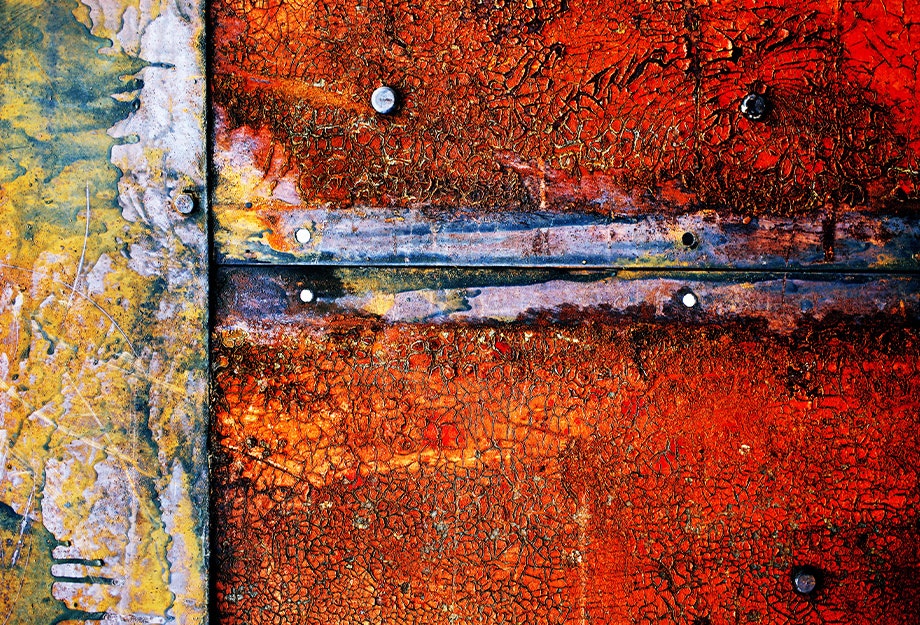
How To: Restore Brass & Stainless Steel Metal Hookah Pipes
Here at Hookah-Shisha, we see our fair share of hookah styles of all makes and models. The variety of hookahs that have come through our doors over the years is pretty incredible.
I bought my first hookah with Hookah-Shisha, and I've had my job here for almost ten years.
It's always exciting to see what new products come into the market, and in the early days, it was really fun to look at older discontinued models or prototypes which never made it.
I came across an old, brass Syrian-style hookah I salvaged years ago. I thought it would not only be interesting to restore it but also a good insight to share how to do so.
Have you seen random hookahs at garage sales or has someone given you one that they found?
Maybe you've started your own collection and some have sat for a while but would clean up well. Here I'll show you the process of restoring my brass hookah and also some handy tricks and tools you can use to restore or clean up your other types of hookahs.
What Are Brass hookahs?
Hookahs have been around for hundreds of years. They have been made from all sorts of alloys, copper, and brass. Most of the hookahs you find today will be made from stainless steel.
When I first started here at Hookah-Shisha we were still able to get some Syrian hookahs and bases. A lot of them were entirely brass including the tray, hose ports, and purge valves.
Some of us were lucky enough to grab a few before they disappeared from the market [for a while], even if they were just the defective ones. I've owned three of these full brass hookahs in my time here as well as some of the newer brass alloy hookahs.
These older brass hookahs were mainly for decoration or show therefore I never took the time to restore them let alone use them (Ok, I may have used one of them a couple of times if I remember right). This was the first brass hookah I've fully restored although I used my experience from other brass projects I've had in combination with my experience with hookahs.
If you've ever owned anything brass you know it tarnishes just as several other types of metal do. This tarnish you see comes from the metal undergoing a reaction with the oxygen in the air as well as other factors like the oils on your hands.
Tarnish is totally normal and not a sign of anything bad. I personally enjoy the natural patina that comes from tarnish and some say it can bring out details in designs.
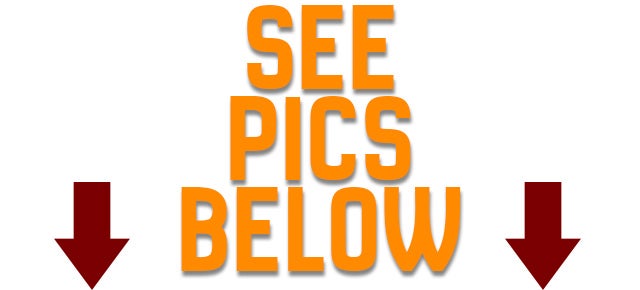
For a hookah, you obviously want to remove any internal tarnish if possible when the entire stem is brass.
Polishing up brass is best done with a soft-bristled brush, paper towels, a coarsely threaded piece of cloth (ex: a towel or terry cloth), a softer piece of cloth material (something like a polishing rag or t-shirt), and a type of non-abrasive cleaning agent/polish.
There are several types of cleaning agents you can use, and the most common one used for brass is called Brasso.
Another one is called Never Dull but I used that one to show you what it does for stainless metals further below. You can also use some household things to clean up brass, and I demonstrated some test spots on the tray of the hookah I restored to show you the differences.
One of the other things you can use might surprise you. Ketchup. Yup! Ketchup and tomato sauce, or paste, can clean brass and is a natural alternative to chemical cleaners. You'll want a thin coat and let it sit for about 30-45 minutes. This generally works on a not-so-heavy-duty job.
It also is best to use the most organic option here as ketchup that is more processed will contain artificial dyes which may temporarily stain the brass leading to another layer to clean off.
Another alternative to chemicals you can use is a mixture of flour, white vinegar, and fine grain salt. When using this mixture I tend to go light on the salt as it can be too abrasive, but just a little will help with the scrubbing.
As with any restoration project, it is always best to determine which method you're going to use and do a test on a small, discrete spot.
Brass hookahs are still available on our website and they're mainly found within the Shika brass hookah collection. You'll find that same golden color seen in the pictures below available as new models with some new-age designs.
How-To Restore Brass Hookahs
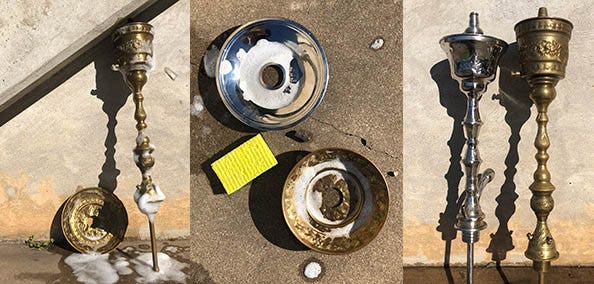
Here we go. First things first; are you sure it's brass? Magnets will not stick to brass so give it a check. If the magnet sticks you could have something that is brass plated.
If you're not dealing with solid brass be mindful of this when doing your polishing as you could get carried away and start to take away the brass plating.
The hookah I worked with is solid brass and it had been sitting for a while so it definitely had a heavy tarnish. Before getting into the polishing remove all of the hose adapters and purge valves if you can and do a once-over solid cleaning with soap and water.
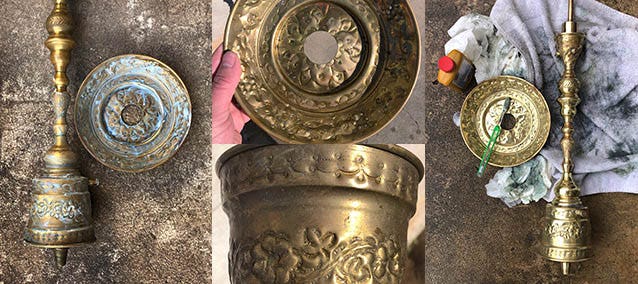
I used the backside of a sponge and toothbrush to give everything a detailed wash. This won't take away the tarnishing, but there was a lot of dirt and dust built up. Next, I started with the tray to 1) test out the cleaning solutions I mentioned and 2) get a rough idea of how much work it would take to get the amount of polish I wanted from the brass.
I knew I wanted to use Brasso on this hookah only because of previous experiences, and I wanted to see how shiny I could get this.

The first segment of this photo is the portion of the tray I used ketchup on. The middle section is the flour, vinegar, and salt solution. The last portion is with Brasso.
An interesting detail to mention is the result from ketchup definitely cut through the layer(s) of tarnish but left the brass looking slightly dull as compared to Brasso.
The middle second definitely got cleaned well, but the paste mixture wasn’t enough to cut through the heavy tarnish. I would say this was too tough of a job for that option. [There’s a reason for that abomination of a smell from Brasso]
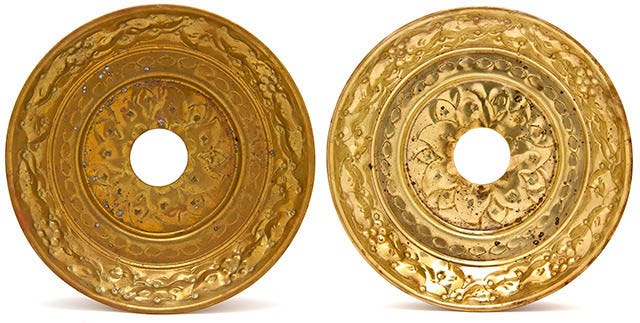
With a project of this size, it helps to do a general overall polish to start and then focus on small portions at a time. The residual solution that's left from your first wipe down will continue to cut through the tarnish so when you come back for a second or third time it'll continuously get easier.
It's also helpful to have several paper towels on hand as you'll see they get dirty quickly with each layer you polish off. Patience is key. [That black stuff you see on the what-was-white towel is the tarnish being transferred off of the hookah. You’ll notice that it oxidized after I was done - turning green as it does on brass.]
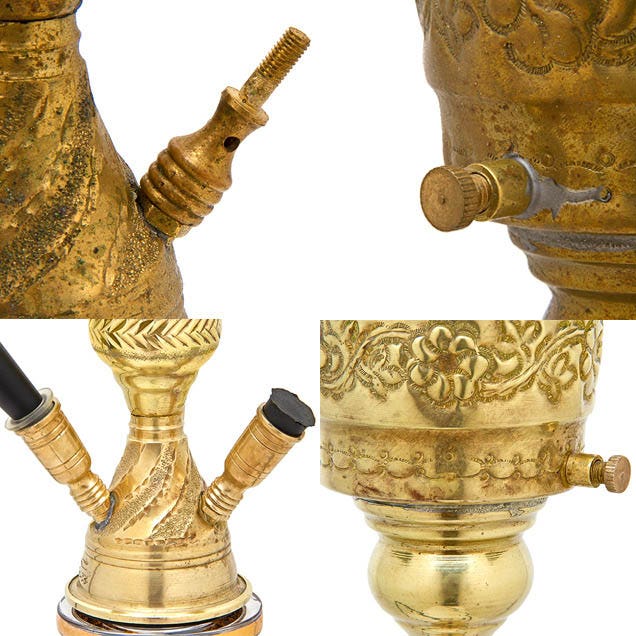
This took about three rounds of Brasso with paper towels and a toothbrush to achieve. After the second round, I did a dry cleaning with a towel to remove all of the dirty Brasso leftovers.
Then I did my last round of Brasso with paper towels. My final cleaning pass on the stem and tray was with an old t-shirt to polish everything up and remove any remnants of Brasso.
Finally, I used an even softer cloth to do a super-shine polish. As for the hose adapters, I coated them with a thick coating of Brasso and let them sit during the entire duration it took to clean the stem and tray.
They only took one pass by doing so. The trickiest part of this restoration was the interior downstem tubing.
Even after the initial soap and water scrub, I still put a small amount of baking soda with lemon juice on a cleaning brush and scrubbed the inside of the stem several times.
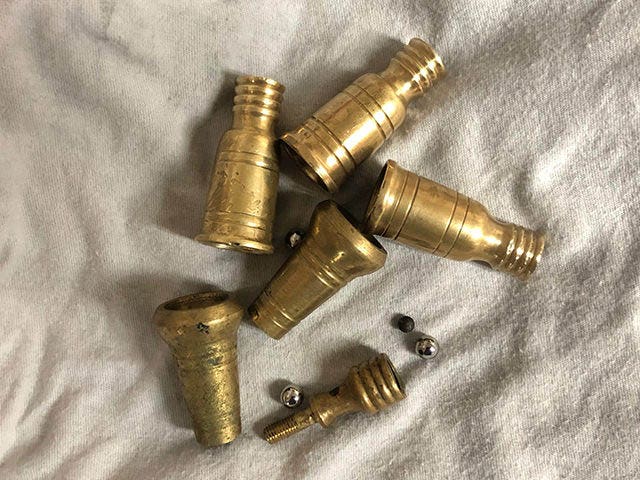
Last came the time to assemble everything and find a base. If you noticed, I was also missing the decorative piece for my purge valve. If you have really keen eyes, you may have noticed my hose adapters were different.
For that reason, I decided to change the purge valve to another hose port (I may end up making my own unique piece for the purge valve at a later time) and changed the hose adapters to all match.
After some new ball bearings and a base, this hookah was finished.
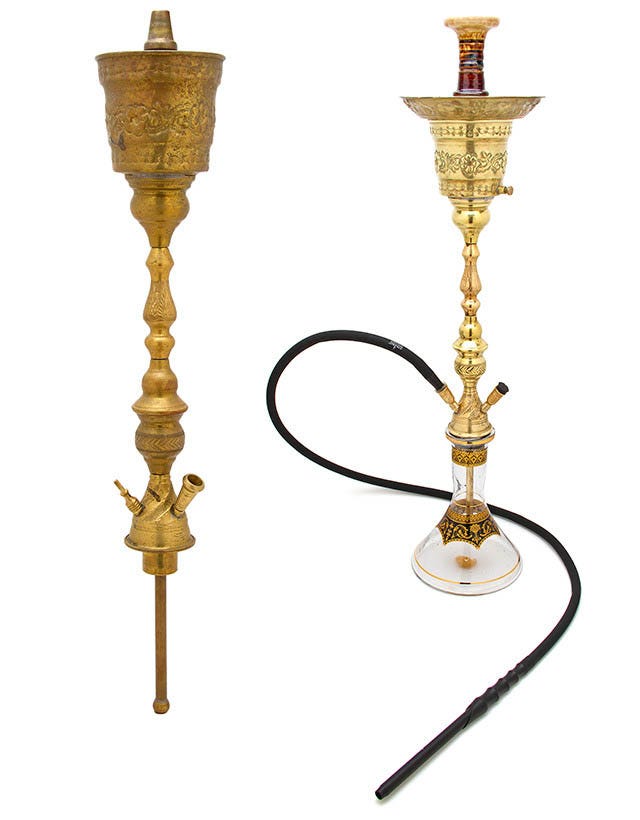
With some brass items, a lacquer coating is applied to protect the metal and a heavy cleaning like this is not necessary. With most hookahs however you won't have a lacquer coating. You can find a few options to help protect polished brass from tarnishing quickly like linseed oil.
How-To Restore Stainless Steel Hookahs
You can use similar methods for polishing up other types of hookah metals. Most of the traditionally made hookahs you'll find today are made from stainless or aluminum alloys.
Other than the usual fingerprints from normal handling, these types of hookahs won't tarnish as quickly or sometimes at all. In many cases, the tarnish is very light and can be easily rubbed off with a cloth.
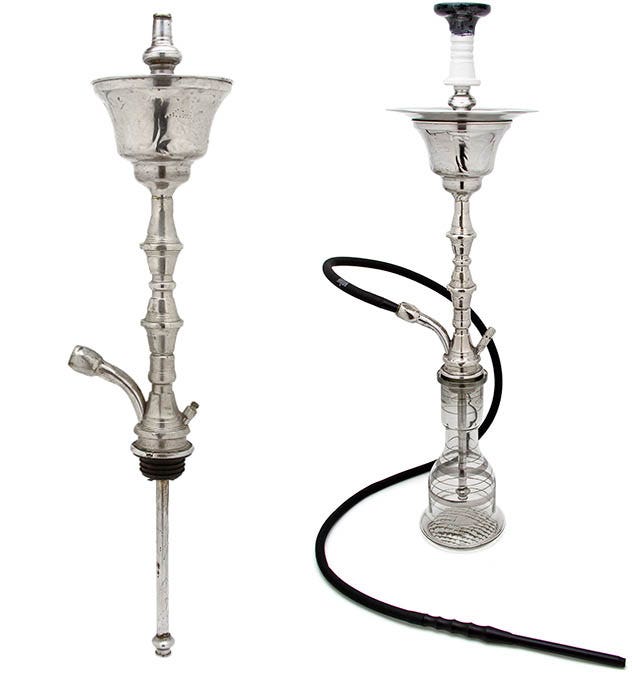
If not, as I did in the example below, you can restore the finish by using a cleaning agent and a little bit of elbow grease.
It's also worth mentioning machine-made hookahs, from brands like Mya or Amira, for example, do not tarnish because of the materials they are made from. The following methods are NOT necessary for these types of hookahs and could potentially damage any protective coating or finish on the hookah.
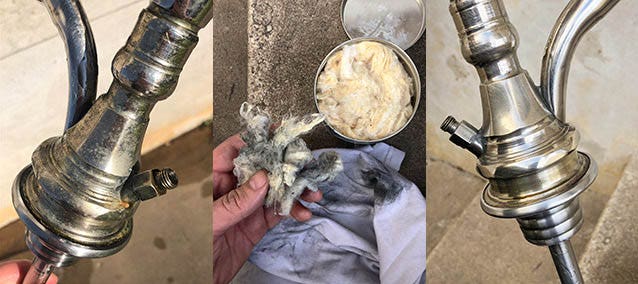
One of my favorite metal polishing tools is something called Never Dull. It works on a variety of metals and seems almost like magic because of what it can do. The secret with this stuff is the cleaning agent is delivered by a soft, micro-abrasive fiber. It's similar to a Magic Eraser in that the fibers are so microscopic they will softly scrub without causing damage - no scratches! I used Never Dull on the hookah below.
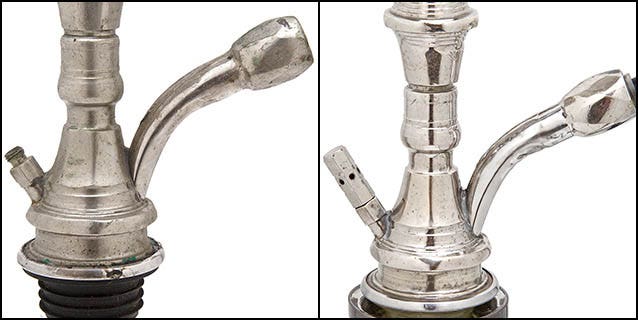
I basically did the same steps as I had with the brass hookah. The difference with this stem is I let it soak in hot soapy water while I worked on my brass stem - so about 45 minutes. This was mainly to soak the inside downstem.
An overall, deep clean with soapy water using a sponge and toothbrush was my next step for the exterior. I dried the stem and then did one pass all over with the Never Dull cloth and finished with a dry wipe down with a t-shirt.
You should do another rinse after you're finished with the Never Dull to remove any residue left from the cleaning agent. The Never Dull isn't a paste like Brasso; it's more like an oil, and it’s potent.
For the areas around the hub and purge valve, I did do one pass with a flour and vinegar solution I had mixed up until it was sort of a thick paste. I did this before I applied the Never Dull.
This was mainly for cleaning out the dirt/dust from tricky areas.
Tools and Tricks
Everything I used in the examples above is listed here. I've also included some other helpful things to have on hand while cleaning up your hookah. You can get creative here with your cleaning tools if needed.
I've used pipe cleaners before for tricky spots, some wire to help thread clothe through a downstem, and who knows what else on other cleaning projects involving hookahs.
Just be careful with highly abrasive stuff so as to not scuff up the finish on your hookah and parts. I'll also say it again; always do a test first in a small, inconspicuous spot before going all in!
- Cleaning clothes - It's helpful to have a few, as they'll get dirty as you go.
- Paper towels - In combination with your towels or similar, these are nice to have for the really dirty cleaning.
- Base cleaning brush
- Stem cleaning brush
- A toothbrush or other small, semi-soft brush - Something along these lines is super useful to have for detailed areas or small spaces
- A sponge - A good ol' kitchen sponge works great, but amp it up with a dual-sided sponge that has a rough scrubbing surface on one side.
- Mild soap/detergent - Dishwashing soap is a great overall option here. You could use any "general purpose" liquid soap.
- Brasso - Great for several types of metal but a powerhouse when it comes to brass
- Never Dull - Again, very useful and powerful on all types of metal but particularly great with stainless steel. This can also double as a scrubbing tool as the spongey, cotton-like material does have a micro-abrasive effect.
- Baking soda and lemon juice - In combination, this works as a cleaning agent for bases and stems. You can make a paste out of these two ingredients for scrubbing, or you can dilute it with warm water to soak the inside of a base or stem.
- Vinegar, flour, and salt - These three together make a great cleaning solution and a light polishing solution.
- Bling Glass Cleaner - Great for the base and shaft interior
Finding Parts
In the case you are dealing with an older hookah you've come across or have been gifted, you may find yourself needing parts. The good thing with hookahs is that a lot of pieces are universal.
Most bases are roughly the same size when it comes to traditional hookahs, and bowls and hoses are typically easily interchangeable. Sometimes, however, you may be missing a purge valve cap or a hose port adapter. Maybe you have a more modern hookah that has a threaded base. In these cases, we may be able to help.
Don't hesitate to contact us if you're looking for something specific. Some commonly tricky things are finding the correct threading diameter with hose adapters and purge valve accessories or finding the right grommet to fit a base/stem combo. We're here to help, and we have extensive knowledge of an incredible amount of different types of hookahs.
Categories
Month List

